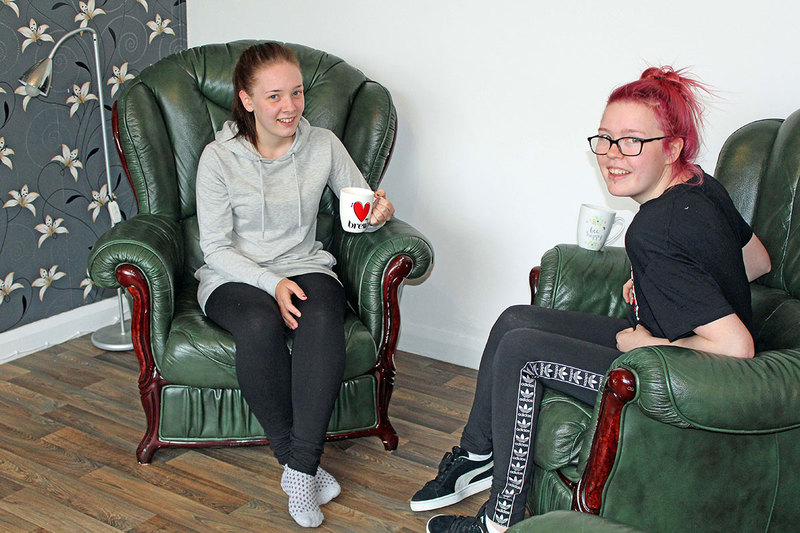You are viewing 1 of your 1 free articles
Shared housing: the solution?
Shared housing for social tenants could be the next big thing due to government plans to cap housing benefit for single under-35s. Kate Youde asks if it’s an appropriate solution. Illustration by Leandro Alzate
When 18-year-old friends Teri Blundred and Beth Larravide moved into their new furnished home in Kidsgrove, Staffordshire, in June, they made Aspire Housing history. Theirs is the first joint tenancy ever offered by the association. The pair, who are studying at Stoke-on-Trent College, share a two-bedroom maisonette but each has her own tenancy agreement with the landlord. “I’d prefer to live by myself but, for now, it works out a lot cheaper sharing with someone,” says Ms Blundred.
The charity Arch North Staffs partnered with Aspire on the maisonette after receiving funding from Crisis to develop shared housing with social landlords. Crisis is providing a total of £150,000 a year for two years to six Help to Rent programmes that are assisting homeless people, or those in temporary accommodation, to access sustainable housing. Four of these projects are delivering shared accommodation pilots for younger people who will be affected by the introduction of the Local Housing Allowance (LHA) cap in social housing.
From April 2019, the rent covered by housing benefit for single, childless tenants who are under the age of 35 and on Universal Credit – or those on housing benefit whose tenancies began or have been renewed since April 2016 – will be capped at the shared accommodation rate (SAR) of LHA unless an exemption applies. As a result, many tenants face a shortfall between the benefit they receive and their rent.
LHA is a flat rate set at the 30th percentile of market rents for properties within a broad market rental area. Sinéad Butters, chief executive of Aspire and chair of Placeshapers, says 8,500-home Aspire operates in a low-value area and the LHA cap rate is too low to cover the £75 weekly rent for a one-bedroom flat. The SAR is £52.02.
Ms Butters says: “I think the challenge for us [as housing associations, particularly in low-value areas] is who houses the people who can’t afford the rent?” She says the “flawed policy” may mean associations face “unpalatable choices” and more people become homeless.
Aspire hopes to offer up to 100 shared tenancies over the next two or three years in response to the cap. Ms Butters says it is an “innovative solution”, although she admits people don’t aspire to share. “It’s not a panacea to the LHA levels in low-value areas,” she adds. “The solution has to be the government addressing the inequalities of a policy that has been applied across the country that doesn’t meet the needs of different geographies.”
But social landlords must deal with the policy as it stands. As well as preparing affected tenants by giving financial advice and employment support, many, like Aspire, are turning to shared accommodation – something of which there has been very little in social housing outside of supported accommodation. So what are some of these associations doing and what can others learn?
Shocking shortfall
Concerned about the impact of the cap, the Consortium of Associations in the South East (CASE) commissioned research from the Centre for Regional Economic and Social Research at Sheffield Hallam University. The report, Capping Aspiration: the Millennial Housing Challenge, published in May, found that 84% of single social housing tenants in the South East of England would experience a shortfall if the SAR was applied to their current claim. On average, this shortfall would be £55.11, leaving someone under 25 on Jobseeker’s Allowance who needs to make up the shortfall with just £2.79 a week for other living costs.
Clare Powell, director of strategy at 55,000-home Sovereign, says CASE members were “shocked” by the scale of the shortfall and “discouraged” to find that the vast majority of existing models of shared accommodation studied would not be viable from April 2019 because rents were above the SAR. That left associations questioning what housing solution they could provide.
“The gut instinct of housing managers is [that] shared housing isn’t a great solution for everybody and I think that’s particularly the case when you think about the groups of people in this age group,” says Ms Powell. For someone to get high enough priority to be housed by an association, she says it is unlikely shared accommodation is the correct solution unless support is in place. The solution does not need to be supported housing, but it does need “intensive housing management”, she suggests.
The dilemma that associations face is whether the costs are carried by the entire tenant population to keep rents down for this group.
Landlords considering providing shared accommodation for under-35s might be able to learn from Yarlington Housing Group, which has produced an internal report halfway into a year-long trial. It has two three-bedroom shared houses in Yeovil and Bridgwater, in Somerset, and will bring two more three-bedroom houses into the tenure this year.
The 10,000-home organisation is testing whether shared accommodation will be affordable for the association (will there be rent arrears?), whether its “biggest worry” of anti-social behaviour (due to putting younger people into what were family units) is valid, and what a future service offer should look like.
Taking inspiration from private rental shared accommodation, Yarlington is providing basic furniture and white goods, and has fitted locks to bedroom doors and kitchen cupboards. First Choice Homes Oldham, which is about to pilot two shared homes, is installing broadband as part of its re-let work.
Jim Bruckel, head of operations and customer experience at Yarlington, admits the trial has been “a bit of a mixed bag”. The first tenants, identified with the help of the Yeovil Foyer and YMCA Bridgwater, which also provided transitional support, were “on a pathway of going through supported accommodation” and not all were “tenancy ready”.
For its next two properties, the association will get people to bid through the choice-based lettings system. “That might be a better solution, rather than take three people from supported housing who know each other really well – and may have some baggage and history – and putting them into these units,” says Mr Bruckel.
There have been rent arrears, some of which result from the recent introduction of Universal Credit in Somerset, but Mr Bruckel says they are no different to what the association might expect in any type of accommodation. And despite bracing itself for complaints from neighbours about noise from the shared accommodation, there have been no problems with anti-social behaviour.
“Why should we perpetuate a policy that actually isn’t working?”
Mr Bruckel says there is a “business sense” behind shared accommodation, as there is a potential increase in income through letting three rooms rather than a three-bedroom house. But he says Yarlington needs to assess whether any gain is offset by increased management costs, including paying council tax (although it can apply for an exemption if a tenant meets certain criteria), and additional costs for repairs and void turnover. A different management style is needed compared with a general needs estate, he adds, including putting in place the correct “house rules” so everyone pays their fair share of utility bills.
Rather than looking at existing stock, Town & Country Housing is building two two-bedroom, two-bathroom houses in Kent under its Smart Sharing pilot. These are due for completion in April 2018 as part of wider developments, with the costs for tenants within the SAR limits. The 9,500-home association has three further projects in Tunbridge Wells in the early planning stages and will start on site on two homes in Wealden, East Sussex, this financial year. Its growth plan is to produce 10 to 15 shared homes per year.
Colin Lissenden, development director at Town & Country, sees the approach as “a very simple fix”. Other landlords have been in touch. “The first thing I have said [is] ‘if you are looking to deliver these for financial reasons, forget it’. We will lose money. For us, this represented a good social investment because we couldn’t see how else we were going to cater for [the cap].”
The SAR is £77.39 per week in Tunbridge Wells so the landlord will receive twice this amount. If it let the same two-bedroom house at affordable rent – in line with what Mr Lissenden says the government wants associations to do – it could get £180. The association favours social rent and would get £125 on that tenure.
Town & Country is building, rather than adapting existing properties, because of the “equality aspect”. The footprint of the houses is the same as similar homes on the sites but the internal walls have been realigned to accommodate an extra bathroom (a shower room that adds £2,000 to the standard build cost) and make the bedrooms the same size. Mr Lissenden wants to ensure the association has an “incredibly strong” exit strategy to be able to let the whole property as one home as it doesn’t know whether shared accommodation will work – and in case the government changes tactics.
Other options
Sue Ramsden, policy leader at the National Housing Federation, is calling for a “wholesale review about the way LHA is set”.
“What the government is doing is applying a cap that is based on something that bears no relation to the way social housing rents are calculated.”
Ms Ramsden says shared housing is expensive to manage and can be unpopular with tenants (see box: Sharing’s on the menu). She adds that there is already “huge demand” for larger properties – which could be split to provide shared accommodation – from families.
Of course, shared housing is only one way associations are responding to the cap. “Consideration is being given to harmonising the rental charge on studio accommodation so that it reflects the shared LHA rate, thus offering a viable option for those under 35-year-olds who will be affected by the LHA cap,” says a spokesperson for 4,000-home Ocean Housing in Cornwall, which has around 80 studio apartments.
Ms Butters says it may make sense for landlords to reduce rents to LHA cap levels if the starting points are high. However she asks: “Why should we perpetuate a policy that actually isn’t working? What we are trying to do is make a government policy work which patently doesn’t work.”
Sharing’s on the menu
A pilot by Bron Afon Community Housing of a three-bedroom house share in Torfaen found “little interest” in shared housing.
Ian Simpson, director of community housing and support, says this might be because there is no real history and culture of sharing in Wales, or there is an “awareness issue” because the LHA cap doesn’t apply until 2019.
However shared housing was one of five options in a separate six-month pilot by the landlord from September 2016 to test housing allocations and support for single people under 35, to mitigate the impact of the LHA cap. The other options were: a standard introductory tenancy without support; a conditional shorthold tenancy with support; a standard assured tenancy without support; and housing options advice and signposting.
Rather than starting its pre-tenancy work four weeks before people got their keys as usual, the 8,000-home organisation engaged with people on the housing register, inviting them to Homeseeker Plus workshops about sustaining their tenancy, finances and employment support. This helped staff and tenants decide on the most appropriate housing option. “It is about fit, but not in terms of a subjective decision,” says Mr Simpson. Bron Afon housed 70 people but there was no take-up of shared accommodation. Average arrears for tenants housed through the pilot were lower than the general average of £297 at the year end, and Bron Afon will use the model for the next three years.











